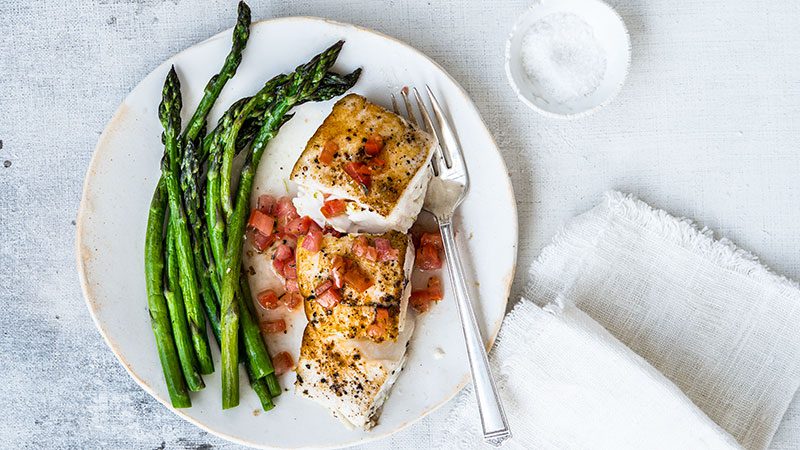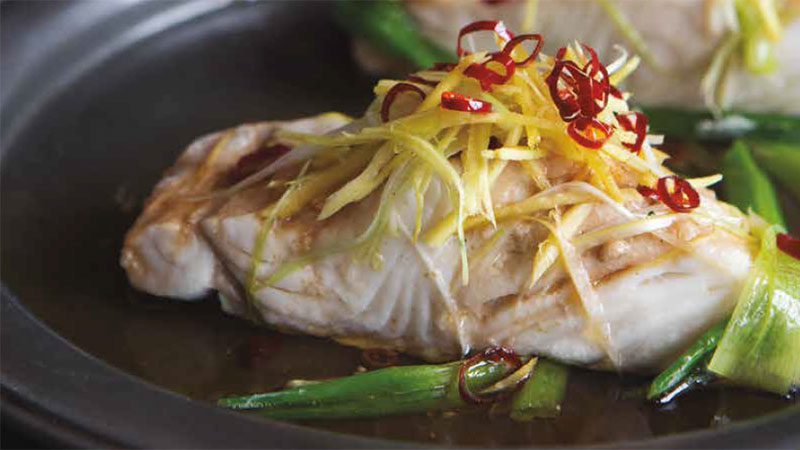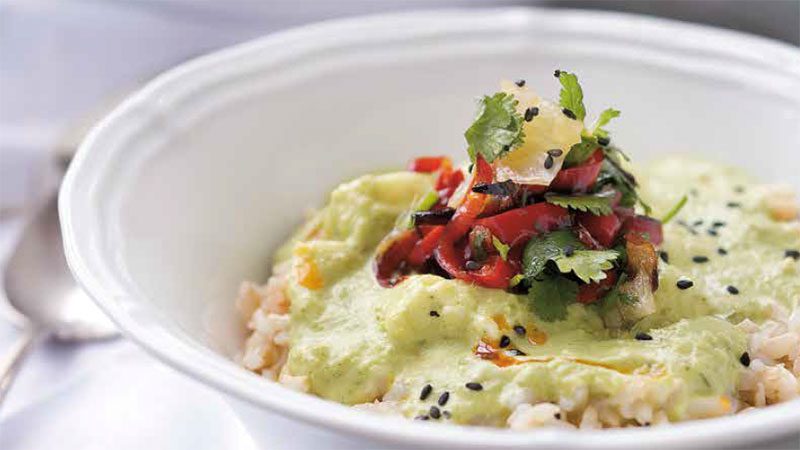Everything you wanted to know about halibut, recipes included
By Becky Selengut, guest contributor
This article was originally published in April 2024

This cheek-y star of spring is “the steak of the seafood world”
Even more than spotting the first crocus, fish lovers know our long, gray winter is over when the first fresh halibut appears in local markets. Salmon may be a scene stealer in the Pacific Northwest, but most of us who make this area our home know that halibut is the white fish waiting in the wings, ready at a moment’s notice. Beloved for its firm, flaky, delicate texture, halibut is often known as the steak of the seafood world.
My first encounter with halibut came early in my culinary career. I was a third-quarter student when my chef-instructor heaved a large halibut up onto a stainless-steel worktable. Halibut filets are called “fletches” and there are four on the big beast, two on top, two on the bottom. It was a massive flat gray fish and it left an impression on all of us, as well as on the wobbling table.
Halibut goes through a fascinating transformation even before you turn it into your dinner. It starts its life as a round fish with an eye on either side of its head, as you might expect. However, by the time a halibut is six months old, it has settled down to the bottom of the ocean and made a transition to life as a flatfish. From then on both eyes—having shifted to the top side of its body—stare up at the world swimming by. Drop this bit of fish morphology at your next dinner party while serving halibut for maximum effect. Follow this up by casually mentioning that small specimens are called “chickens” and big ones are known as “barn doors”.
Halibut’s high cost puts a lot of pressure on cooks to nail their timing and technique, as fish famously have a very small window of doneness. Get distracted for a minute or two and, welp, reach for the mayo, because a flatfish twist on tuna salad might be your dinner. So let’s get you ready for bringing home this very special Pacific Northwest filet and cooking it perfectly.
Why you should eat halibut
Ready for some ‘but basics? Halibut has plenty of advantages:
- It’s sustainable!
The halibut fishery is managed by the International Halibut Commission (IPHC). All halibut purchased at PCC stores meet the co-op’s standards for sustainably caught seafood, which abides by Seafood Watch recommendations and approved certifications. Each year the IPHC sets an annual catch limit, known as Total Allowable Catch, which is then divided among the established fishing areas.
- It has cheeks!
A delicacy if you can find them, halibut cheeks are the finfish equivalent of crab meat and a real treat.
- It’s good for you!
High in protein, low in mercury, wild Pacific halibut also contains Omega-3 fatty acids, selenium and niacin.
- It’s available year-round!
Look for fresh halibut from March through October. For the rest of the year, purchase flash-frozen halibut filets.
- It’s got affordable substitutes!
Can’t swing the cost of halibut? Look for ling cod or mahi-mahi. Can’t find those? Pacific cod isn’t quite the same, but is one of the most affordable whitefish out there.
How to shop for halibut
At the market look for white or off-white flesh, with no dull spots, as they can be a sign of freezer burn. If you spot a yellow tinge to that filet, walk right by, as it’s a sign of age. If you’re not going to use your halibut that day, put it in the coldest part of your fridge or place the package in a colander over a bowl and put some ice on top of it to keep it at its best. If you’re buying high-quality flash frozen halibut (which I recommend, as it’s often frozen at the peak of freshness), simply place the package in a bowl of cold water in the sink and replace the cold water every 30 minutes. For small filets, it will be thawed and ready to be opened and dried with paper towels within the hour. Most halibut filets from the market will come to you boneless, but do check with your finger to see if you feel any stray bones and remove them. You can have the fishmonger remove the skin if you don’t need it for your preparation or watch me skin a fish filet online here if you want to try it yourself.
How to cook halibut
Looking for that restaurant quality sear when you cook halibut? If so, you’ll want to preheat a cast iron or carbon steel pan over high heat. Nonstick pans can’t get hot enough and don’t tend to produce the best crust. Use a few tablespoons of a neutral high heat oil such as safflower or grapeseed. When the oil starts to shimmer, just before it smokes, turn the heat down to medium high, slide the non-skin side of a well-dried filet into the pan and resist touching it for at least 2 minutes. A fish spatula is your friend here. Use it like the pros to slide the edge along the pan’s bottom so that you don’t disturb the building crust. Slide the spatula just under the edge of the filet and peek underneath it to see if it has a deep golden-brown color. If not, let it continue to cook. You have two options once the crust is developed: you can flip the filet over, turn the heat down to medium and cook it until a press on the filet shows that it just wants to start flaking (but not to the point where it fully flakes).
Alternatively, slide the pan into a preheated 400 degree oven and finish the cooking there. The most precise way to determine correct doneness is with a digital thermometer. You will find all different temperatures for perfect doneness for fish, everything from 145 degrees F (according to the FDA) to 120 degrees F for a very silky texture. My sweet spot for a meaty fish like halibut is a range of 125-130 degrees F, at which point I pull the fish off the heat, remove it from the pan to rest for a minute on a plate before serving, at which point that carryover cooking will ensure perfect, meltingly tender flakes with all the moisture and none of that crumbly dryness that has tormented many a home cook.
There are many other ways to cook halibut besides high heat searing, of course (including these PCC recipes). Large pieces or cubes can be gently poached into curries, it can be cooked in the oven in a parchment enclosure or grilled. Save (or purchase) any bones or trim for making homemade fish stock to use in soups, for risotto or paella. If you’re not ready to make that stock, simply keep it in the freezer in a bag until you’re ready.
What to cook with halibut
Halibut pairs really well with foods that are also in season in the spring: artichokes, peas, morels, pea vines, arugula and herbs such as tarragon, parsley, sorrel and mint. It’s delicate but its meatiness can stand up to bigger, bolder flavors, making it fairly flexible. Grill it and serve with charred spring onions, roast potatoes and lime butter. Pan sear it and serve with a green olive tapenade and saffron rice. Whatever you end up doing with your filet – even if you overcook it– be confident that, at the very least, you will end up with the most delicious halibut tuna salad of your life.

Steamed Halibut
with Sizzling Chile-Ginger Oil
Serves 4
1 bunch green onions, white and light-green parts cut julienne, dark-green parts reserved
1 pound halibut filet, skin on, cut into 4 equal portions
2 teaspoons Shaoxing rice wine or pale dry sherry
1⁄4 teaspoon fine sea salt
2 tablespoons finely julienned fresh peeled ginger
1 teaspoon red pepper flakes (use less if you want it less hot)
2 teaspoons soy sauce
2 tablespoons refined coconut oil or peanut oil
1 tablespoon toasted sesame oil
Leaves (and small, tender stems) from 1 small bunch cilantro, for garnish
Bring 4 inches of water to a boil over high heat in a pasta pot with insert or a saucepan with a collapsible steamer insert. Reduce to a simmer. Lay the dark-green onions in the bottom of the steamer insert. Lay the halibut pieces on the scallions, skin side down. Drizzle the rice wine over the filets and sprinkle with the salt.
Cover the pot and steam the fish until the halibut reaches 120°F in the center, 8 to 10 minutes. (It will continue to cook off the heat.) Transfer the fish to a platter. Lay the ginger, light-green onions and red pepper flakes on top. Drizzle the soy sauce over the filets.
Heat a small saucepan over high heat. Add the coconut oil and sesame oil and heat until they shimmer and just start to smoke. Pour this very hot oil over the fish. You’ll hear the ginger and green onions sizzle. Garnish with a generous amount of cilantro.

Halibut Coconut Curry
with Charred Chiles and Lime
Serves 4
2 jalapeños, seeds and membranes removed from one or both (if you want less heat)
2 stalks lemongrass, woody top half discarded, roughly chopped
1⁄2 cup roughly chopped shallots
1⁄4 cup cilantro stems
1 clove garlic
2 tablespoons chopped fresh galangal or peeled ginger
1 teaspoon coriander seeds, ground in a spice grinder
1 teaspoon cumin seeds, ground in a spice grinder
1⁄4 teaspoon fine sea salt
1⁄4 teaspoon dried turmeric, or 1 teaspoon grated peeled fresh turmeric
5 lime leaves, or zest of 2 limes (about 2 teaspoons)
Fish or vegetable stock or water
1 tablespoon high-heat vegetable oil
1 (14-ounce) can full-fat coconut milk
1 tablespoon fish sauce
1⁄2 pound halibut filet, skinned and cut into 1-inch cubes
For the topping:
1 teaspoon high-heat vegetable oil
4 Fresno chiles, seeded and minced (or substitute 1 small red pepper, minced)
2 tablespoons minced red onion
⅓ cup chopped cilantro leaves
2 limes, peeled and flesh cut into small dice
Fine sea salt
Black sesame seeds, for garnish (optional)
Add the jalapeños, lemongrass, shallots, cilantro, garlic, galangal, coriander, cumin, salt, turmeric, and 1 of the lime leaves to the bowl of a food processor or a high-speed blender and blend, using up to 1⁄4 cup fish stock to help the mixture process into a smooth puree. You’ll have to scrape down the curry once or twice. Blend well for at least 3 minutes.
In a medium saucepan over medium-high heat, add the oil. Add the curry and fry it for 2 to 3 minutes. Add the coconut milk, fish sauce, and the remaining lime leaves. Bring to a boil over high heat, then reduce the heat to medium-low and simmer for 10 minutes. Return to a boil and add the halibut, tucking it under the liquid. Immediately turn off the heat and cover the pot (remove the pot from the burner if you have an electric stove). Let the curry sit for 5 minutes so that the fish poaches gently. Taste and adjust the seasoning.
To prepare the topping, heat the oil in a small sauté pan over medium-high heat. Fry the chiles and onion until they are browned, about 10 minutes. Remove the pan from the heat and stir in the cilantro and lime. Season to taste with salt. Serve a spoonful on top of each person’s curry. Garnish with sesame seeds.
Roasted Halibut
with Radicchio-Pancetta Sauce, Peas, and Artichokes
Serves 4
1 pound halibut filet, skinned, cut into 4 equal portions
⅛ teaspoon fine sea salt
1 tablespoon high-heat vegetable oil
1 tablespoon extra-virgin olive oil
2 ounces pancetta, lightly smoked bacon, or prosciutto, cut into medium dice
½ cup sliced shallots
¼ pound radicchio, chopped into bite-size pieces (about 3 cups)
1 teaspoon honey
1 tablespoon white wine vinegar
1 tablespoon white wine or dry vermouth
1 cup fish stock, clam juice, or vegetable broth
½ cup frozen, canned, or jarred artichoke hearts, quartered (thawed and patted dry, if using frozen)
½ cup fresh or frozen peas (thawed if using frozen)
½ lemon
Preheat the oven to 350 F.
Lightly season the halibut filets with the salt. In a large ovenproof skillet over high heat, add the vegetable oil and sear the filets for 3 minutes, or until they are browned on one side. Transfer them to a plate, and reduce the heat to medium-high.
Add the olive oil, pancetta, and shallots, and cook until the pancetta starts to crisp, 5 to 6 minutes. Add the radicchio and honey, and cook for another 3 to 4 minutes, or until the radicchio wilts and caramelizes. Add the white wine vinegar, white wine, and fish stock, stirring to loosen any bits clinging to the skillet. Add the artichokes and peas, stir, then nestle the halibut pieces back in the pan, browned side up.
Place the pan in the oven and cook for 3 to 4 minutes, or until the internal temperature of the halibut reaches 125 to 130°F. Finish with a squeeze of lemon juice over the top. Serve each person a piece of fish and a portion of vegetables, ladling the broth over the top of the fish.
Recipes adapted from Good Fish: 100 Sustainable Seafood Recipes from the Pacific Coast, by Becky Selengut.
Becky Selengut is a chef, cooking teacher and the author of numerous cookbooks including Good Fish: 100 Sustainable Seafood Recipes from the Pacific Coast. Her latest book is Misunderstood Vegetables: How to Fall in Love with Sunchokes, Rutabaga, Eggplant and More.
